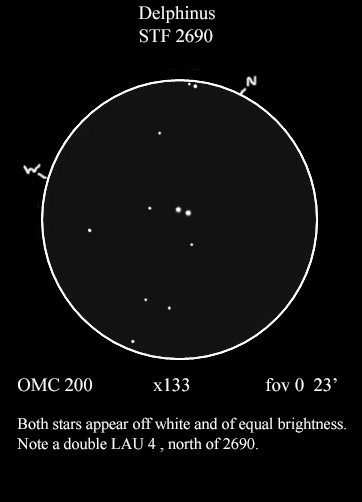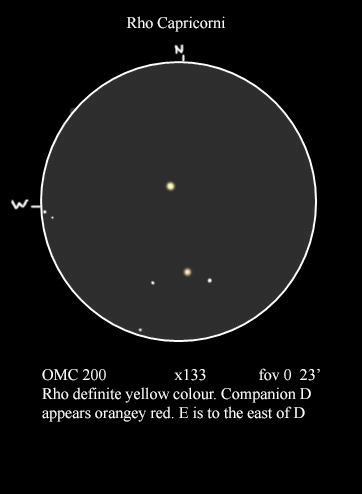Observations of RHO CAP
These are the observations available for RHO CAP. If you have any of your own that you'd like to submit we'd love to put them on the website.
-
More August Double Stars
August 4th: A better night than the 3rd, but still unsteady conditions in the long clear spells from midnight onwards. Again observing with the OMC 200.
Firstly, another look at STF 2690 – very nice, confirmed LAU 4 observation as well.
Then I moved to BU 63 in the hope of splitting it. Using x 320 I could just detect the two stars but at x 400 it was easy. I dwelled on the pleasure of seeing these two little specks of light wobble and dance together in the unsteady air.
Then back up to STF 2690 for another look.
Next I headed to Rho Capricorni in the hope of splitting this tight double. I did better than last night but struggled as it has such a low declination. In moments I think I could split the pair but I could not be certain.
To finish this little tour I wandered over to Omicron Capricorni – a lovely sight of two white stars.
The next hour or so was spent touring Cassiopeia doubles. So many lovely coloured gems to enjoy and multiples as well; a great night out under the stars.
Mike Wood - 5 August 2016
-
Observations of the Double Stars for August 2016
I had last visited STF 2690 only a few weeks ago so it was great to have the excuse to revisit this double; not that an excuse was needed. STF 2690 is one of my list of nine doubles in Delphinus that are “worthy of a visit”.
August 3rd was not a great night but a promised gap in the clouds arrived on time and as Delphinus appeared I was ready to sketch STF 2690. I see both stars as off white. Catching my eye for the first time was a pair of faint stars to the NW of 2690. On looking at my charts they turned out to be a faint double known as LAU 4 (mag 10/11.3). Conditions were not steady enough to attempt to split BU 63 to the SW of 2690.

Also quite recently I had visited Rho Capricorni on a particularly good night and successfully split Rho (yellow) The D companion appeared orangey red and nearby component E was easily spotted. (Star C at mag 13 is beyond the scope). So having enjoyed STF 2690 I wandered down to Rho but was unable to split it but D and E were easily visible. Viewing doubles at these low declinations does not make for easy colour identification.

Mike Wood - 4 August 2016